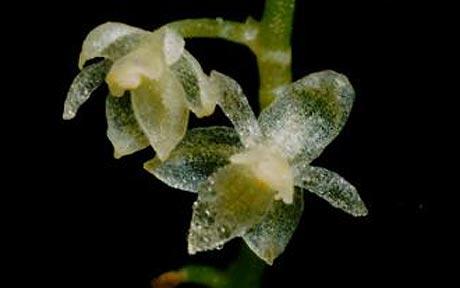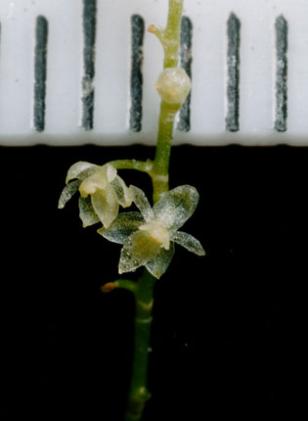tags: new species, biology, botany, orchid, tiniest orchid, Orchidaceae, Platystele, Lou Jost
A close-up of the world's smallest orchid, at just over 2mm from petal tip to petal tip.
Image: Lou Jost.
The world's smallest orchid was discovered recently in a mountainous nature reserve in Ecuador by American botanist Lou Jost. Dr. Jost, a former physicist, now works as a mathematical ecologist, plant biogeographer and conservation scientist, and is one of the world's most expert orchid hunters. In the previous decade, Dr. Jost discovered 60 new species of orchids and 10 other new plant species. He discovered this diminutive plant whilst examining another species of small orchid that he was cultivating.
"I found it among the roots of another plant that I had collected, another small orchid which I took back to grow in my greenhouse to get it to flower," Dr. Jost stated. "A few months later I saw that down among the roots was a tiny little plant that I realized was more interesting than the bigger orchid."
"Looking at the flower is often the best way to be able to identify which species of orchid you're got hold of -- and can tell you whether you're looking at an unknown species or not," explained Dr. Jost (pictured at right).
The tiny flower is just 2.1 millimeters -- less than half an inch -- across and the petals are only one cell thick: the flower is transparent. This discovery has been tentatively classified as a new species of Platystele, a genus that is primarily comprised miniature plants.
Previously, another orchid, Platystele jungermannioides, discovered in 1912, was recognized as the tiniest species known in the world.
Dr. Jost, an expert orchid hunter, recently discovered another tiny orchid that is new to science while searching the Rio Anzu Reserve in central Ecuador.
"It was so small, it looked like a piece of dirt at first," said Dr. Jost of that plant.
"I was going through the moss on a fallen tree branch -- they're good places for orchids to grow -- when I spotted it. The flower was 3mm across."
That previously unknown small orchid is another Platystele species.
This newest plant species was collected in the Cerro Candelaria reserve in the eastern Andes Mountains. This 2113 hectare reserve, comprising mainly Cloud Florest and Paramo (tropical alpine grasslands), was created by the EcoMinga Foundation, based in Ecuador, in partnership with the World Land Trust in Great Britain. Dr. Jost is a cofounder of the EcoMinga Foundation.
The Cerro Candelaria reserve is a rich biological transition zone that stretches between the Sangay National Park in the Andes Mountains towards the Los Llanganates National Park in the Amazon River Basin. The Cerro Candelaria region of Ecuador is known for its many tiny orchid species, and it is home to a number of rare and poorly-known orchids, including an orchid genus found no where else. Already 16 species of orchid new to science have been discovered in this reserve as well as a new species of frog and a new species of tree that will be named in honor of Sir David Attenborough. This nature reserve is also home to threatened animal and bird species such as the White-rimmed Brush-Finch and the Mountain Tapir, Spectacled Bear and Ocelot.
"It's an exciting feeling to find a new species. People think everything has been discovered but there's much more," Dr. Jost pointed out.
Dr. Jost's most dramatic discovery so far was 28 new orchid species in the genus, Teagueia -- which had previously included just six species. Teagueia orchids are a spectacular plant radiation that evolved in an area that is smaller than the island of Manhattan. The radiation of these 28 closely related orchids in such a small area is celebrated as a botanical version of Darwin's finches.
Road construction through the most remote and pristine regions in Ecuador has led to the discovery of more than 1,000 orchid species in the past century. These species that are new-to-science are eagerly pursued by orchid collectors, greenhouses and breeders as well as botanists and other scientists throughout the world.
Sources and Background Reading:
Smallest species of orchid discovered hidden in another plant (quotes).
Lou Jost's profile on Nature Network.
Lou Jost's Monograph of the Genus Teagueia. Fascinating reading about all these new orchid species. Includes comments about unresolved taxonomic issues in this genus and images of each flower.
Read more about the Cerro Candelaria nature reserve.
Read more about the EcoMinga Foundation.
Read more about the World Land Trust.
Doomed To Die? Sports Illustrated Magazine.




Thanks for the story, but there are some huge errors I must correct. I certainly did not discover P jungermanniodes, nor did I see it in Ecuador. I had seen other small Platystele here in Ecuador (not P jungermanniodes, which has been known since 1912 and not even found in Ecuador), and those are what my quotes referred to. I did find this new, smaller one, though.
Wow.
Does it really have one cell thick petals Dr. Jou? I assumed there had to be at least two outer layers of epidermis and a parenchyme, which are three layers.
I suspect if it is relly only one cell layer thick, it maybe has a interesting derived leaf development. In animals at least, organs are built by inductive signals between different tissues, often between mesenchyme and epithelium. if one is missing, no organ forms. If I may suggest this, you should ask some Arabidopsis people you know if they are interested in this plant.
What I always wonder about is how do you make sure you haven't just taken the only remaining specimen from its natural habitat?
Also, are you taking steps to prevent the collectors from trampling all over the area in search of these few interesting plants, destroying the myriad species of plants and insects?
Jerry, if it's the last surviving individual, it's probably safer in a good glasshouse than in the wild. Apart from anything else, whatever killed off the rest is presumably still out there. WRT the other question, most field biologists/botanists I've met have had a pretty good instinct for not trampling plants (so do a lot of gardeners!) acquired from years of watching where you put your feet until it became automatic. Plenty of types of plant will recover quickly from being trodden on, so you step on them not on the fragile ones. I'm not saying there'll be no damage, but probably no more than any of the local medium to large mammals will cause.
thanks for the clarification, Dr. Jost.
Mo, the comment about the flower being one cell layer thick is based on casual observation under low magnification. I'll have to look at it with more magnification to really be sure...
Jerry, Stripey-cat makes good points. Anyway this is an epiphyte, growing in trees, so no chance of trampling. And I am the only orchid person who has ever gone there. Friends and I started a foundation to protect these forests where these and other unique orchids grow, and we actually pay two guards to keep orchid collectors and hunters off this particular mountain (which we have now purchased and made into a reserve--www.ecominga.com). However, this particular orchid is so small and inconspicuous and inaccessible up in these enormous mossy epiphyte-laden trees, that there is no chance that a collector could have much effect on its population.
By the way, just to put this place in perspective, it is at least one and a half day's hard uphill hike from the nearest road, and on a knife-edge ridge which is so steep on either side that no one ever would walk off the ridgeline path (which was made not by people but by Spectacled Bear and Maountain Tapir). This is not a city park.
Lou
Wow. That's just...that's stunning.
Ecuador is such a diverse and peaceful country. The weather, the colonial cities and the people are just fantastic. Nothing compares to the landscapes of the Highlands, the lush of the Amazon Rainforest, the exotic Beaches of the Coast and the mystery of the Galapagos Islands.
Uh, yeah. Much less. More apt to say "less than a tenth of an inch."
Thank you for the answer, Dr. Jost.
"Jerry, if it's the last surviving individual, it's probably safer in a good glasshouse than in the wild"
Yep. Remember Franklinia.
Re: can they really only be one cell thick?
Basic rule in Botany - "Plants can and will do any damn thing they please, regardless of your textbooks."
:-)
I wonder how these orchids propagate - can they be bred to become larger? Or smaller! If this plant can reproduce via seeds, what insects pollinate it?